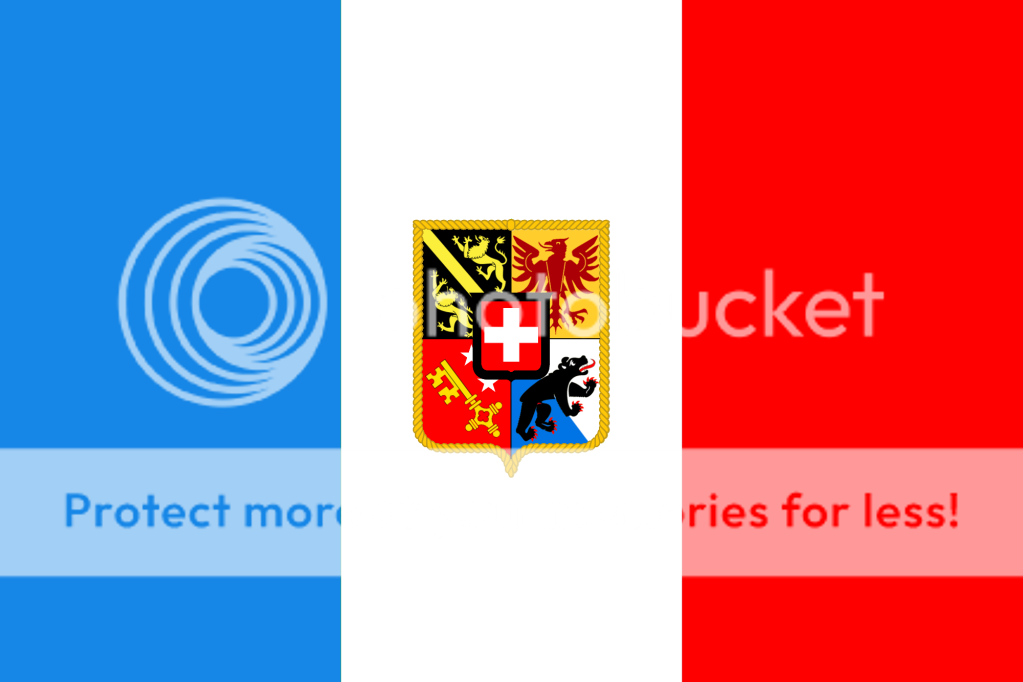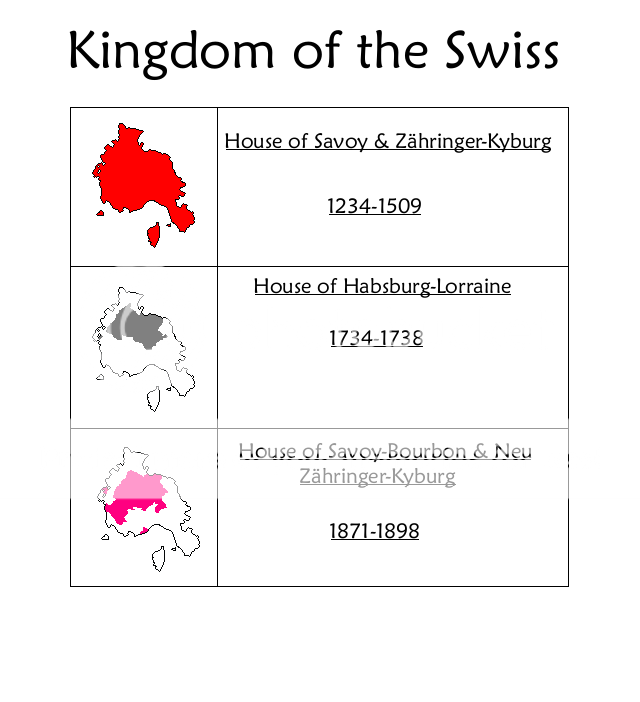Kingdom of the Swiss
Kingdom of the Swiss
(
Italian: Regno dei Svizzero ; German: Königreich der Schweitzer ; French: Royaume de la Suisse)
First Monarchy: 1234-1301 (
Union between the Zähringer and Kyburg Houses)
- Conrad II of Zähringer-Kyburg, King of the Swiss: 1234-1278
- Berthold VI of Zähringer-Kyburg, King of the Swiss: 1278-1301
First Regency Period - Beatrice of Savoy: 1301-1303
Second Monarchy: 1303-1375 (
Union with the House of Savoy)
- Amadeus V of Savoy & Zähringer-Kyburg, King of the Swiss: 1303-1321
- Humbert IV of Savoy & Zähringer-Kyburg, King of the Swiss: 1321-1368
- Bianca I of Savoy & Zähringer-Kyburg, Queen of the Swiss: 1368-1375
Third Monarchy or Imperial Era: 1375-1438 (
Largest expansion of the Kingdom (see map app.))
- Edward of Savoy & Zähringer-Kyburg, Duke of Genoa-Corsica, Prince of Monaco, Duke of Milan, King of the Swiss: 1375-1411
- Eleanor, “the Golden Queen”, of Savoy & Zähringer-Kyburg, Duchess of Genoa-Corsica, Princess of Monaco, Contessa of Pisa, Duchess of Milan, Queen of the Swiss: 1411-1446
Fourth Monarchy or Warring/Decline Period: 1447-1491 (
French annexation of Monaco; The 2nd Roman Nation’s invasion of Pisa and Genoa-Corsica; Habsburg control over the Holy Roman Empire & expulsion from H.R.E; Rebellion of Milan; Political instability in the Kingdom)
- Victor Amadeus of Savoy & Zähringer-Kyburg, Duke of Genoa-Corsica, Prince of Monaco, Conte of Pisa, Duke of Milan, King of the Swiss: 1447-1471
- Berthold VII (Philip Emmanuel) of Savoy & Zähringer-Kyburg, Prince of Monaco, King of the Swiss: 1471-1487
Second Regency Period - Thomas III, Count of Turin: 1487-1489
- Ulrich Hartmann, Duke of Aargau: 1489-1491
Fifth Monarchy or Final Monarchy: 1491-1509 (
Absorption of Genoa-Corsica and Milan to the 2nd Roman Nation; Franco-Austrian invasion of the Kingdom & Repatriation into the H.R.E; Fall of the Monarchy; Partition of the Kingdom into nations: Duchy of Savoy, The Swissland Federation, State of Baden, Free City of Geneva)
- Hubert of Savoy & Zähringer-Kyburg, King of the Swiss: 1491-1509
The Four Year Kingdom: 1734-1738 (
Realm created by Emperor Franz-Matthias II of Habsburg-Lorraine for his son as a personal fiefdom; ended in the Revolution of 1738 and deposing of the House of Habsburg-Lorraine and creation of the Swiss Confederacy)
- Karl-Josef II of Habsburg-Lorraine, King of Swissland: 1734-1738
The Second Kingdom or 27 Year Restoration: 1871-1898 (
Re-establishment of the Kingdom under the French-Italian exiled Cadet Branch of Savoy-Bourbon uniting with the Neu Zähringer-Kyburg house; Union of the Genoan city state with Geneva into the Swiss Confederecy, forming the Second Kingdom; Final end of the Monarchy and formation of the Swiss Republic, ending the last Monarchy on continental Europe with the exception of the Empire of Sweden (the other monarchies left in Europe being the United Kingdom of Britannia, Princedom of Munster and Kingdom of Sicily-Tunisia))
- Conrad IV (Louis-Amadeus II) of Savoy-Bourbon & Neu Zähringer-Kyburg, Prince of Savoy, Duke of Genoa, Co-Prince of Geneva, King of the Swiss: 1871-1898
- Royal Flag of 1871: The Royal Flag of the Second Kingdom bears the French-Italian tri-colour of the House of Savoy-Bourbon (light blue representing its French line, red the Italian), emblossed with the ancient coat of arms of the House of Savoy & Zähringer-Kyburg (the top two quadrants showing the crests of the ancient houses, with the bottom pair showing the union between the 3 main cities of Bern, Zurich and Geneva, enlaid with a central shield of a greek cross over a red field, the standard of the House of Savoy and a Swiss National symbol), the old coat placed inside a coiled rope shield, representing the former maritime power of the Older Kingdom and the new Duchy of Genoa, over the central field of the tri-colour (white):
- Geographical map of the 3 periods:
that is an interesting survival of the RH. Liked the colours!
I was writing it in rush so nobody got this idea before me



